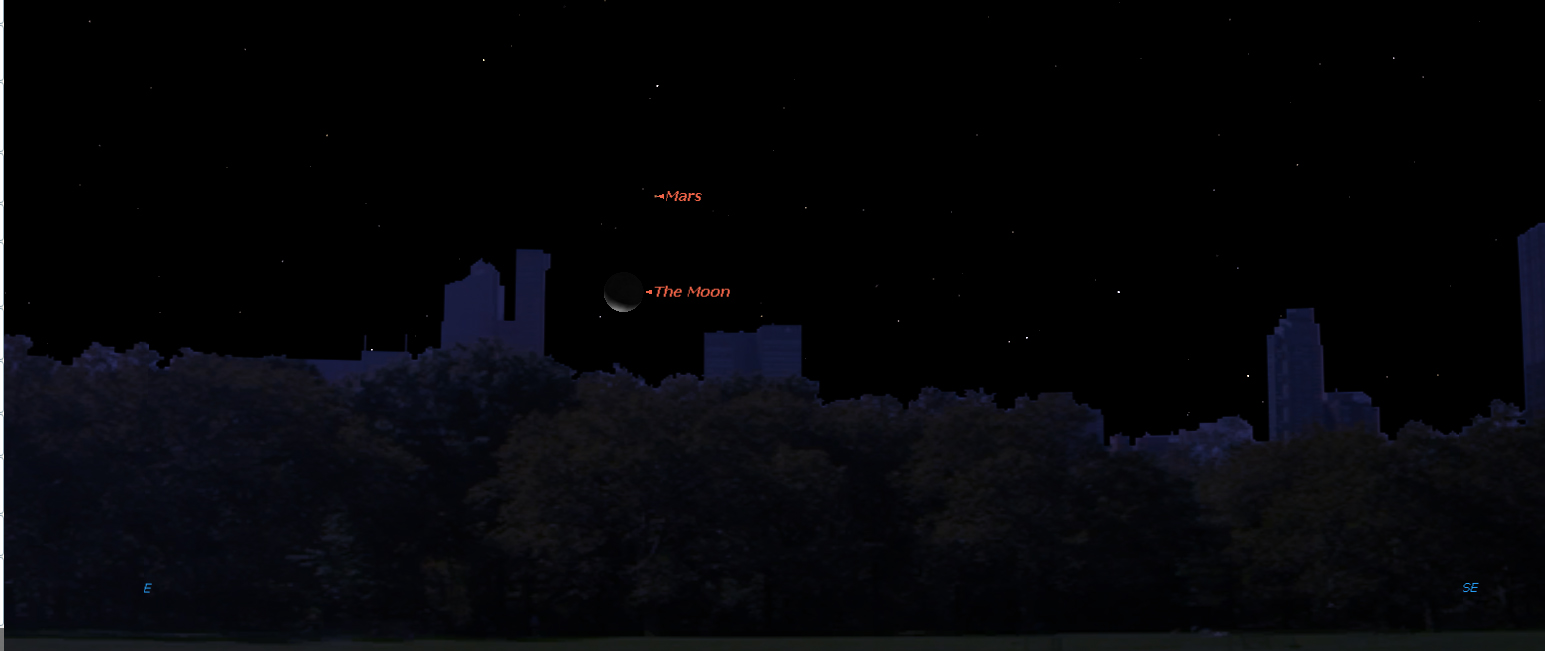
This weekend, the crescent moon will point curious skywatchers toward Mars, which is currently quite dim in the night sky. But don't despair — in early 2016, the Red Planet will be in top form.
Face east-southeast at around 3:15 a.m. local time on Sunday (Dec. 6) morning, and look about 10 degrees above the horizon. (You can measure roughly 10 degrees by holding your clenched fist out at arm's length.) Unless there's a tree or a house obstructing the view, you'll immediately see a lovely waning crescent moon. Once you've spotted the moon, look about 4 or 5 degrees above it (roughly half a fist) and a bit to the right, and you'll see what appears to be a fairly bright "star" shining with a yellow-orange tinge.
But that's not a star at all. It's a planet: the mysterious Mars. The Red Planet will put on quite a show for skywatchers in 2016, even if it appears somewhat dim during early December. [Watch: December's Night Sky Brings Stars, Clusters and Planets (Video)]
Not an eye-catching object … yet.
Admittedly, Mars hardly inspires awe when it comes up slightly south of due east around 2 a.m. these early December mornings. It currently shines at magnitude 1.5, a brightness that, in comparison, would rank it at 22nd among the listing of the brightest stars in the sky. A month from now, however, Mars will appear 32 percent brighter — a sure sign of much greater things to come later this winter and in the spring.
If you aren't awake at 2 a.m., know that when the dawn twilight begins to brighten the sky several hours later, Mars will stand nearly halfway up in the southeast sky.
Because the Red Planet is still too small to show any surface features in most telescopes even when it's well up in the southeast, in order to observe it well, you must have access to a large telescope (one with at least 8 inches, or 20 centimeters, of aperture) and utilize a high-power eyepiece of at least 400 power, and even then, use it only under very good viewing conditions. Summer in the Martian northern hemisphere will be less than a month away on Jan. 3, and if you can get a night where the image doesn't quiver too much, you may notice the Martian north pole with its shrunken ice cap tipped toward Earth.
Getting closer and brighter
Currently, Mars is within the boundaries of the constellation Virgo. There it will remain until Jan. 17, and in the process, it will pass 3.5 degrees north of Virgo's brightest star, Spica, on Dec. 23.
Get the Space.com Newsletter
Breaking space news, the latest updates on rocket launches, skywatching events and more!
Right now, Mars is 178.7 million miles (287.5 million kilometers) from Earth. By May 30 of next year, that distance will have been reduced to 46.8 million miles (75.3 million km), and its brightness will have increased 25-fold; it will then be nearly twice as bright as Sirius, the brightest star in the night sky.
So, when you see that modestly bright object near the moon early Sunday morning, just remember: As far as Mars is concerned, there are better times ahead!
Joe Rao serves as an instructor and guest lecturer at New York's Hayden Planetarium. He writes about astronomy for Natural History magazine, the Farmer's Almanac and other publications, and he is also an on-camera meteorologist for News 12 Westchester, New York. Follow us @Spacedotcom, Facebook and Google+. Original article on Space.com.
Join our Space Forums to keep talking space on the latest missions, night sky and more! And if you have a news tip, correction or comment, let us know at: community@space.com.

Joe Rao is Space.com's skywatching columnist, as well as a veteran meteorologist and eclipse chaser who also serves as an instructor and guest lecturer at New York's Hayden Planetarium. He writes about astronomy for Natural History magazine, Sky & Telescope and other publications. Joe is an 8-time Emmy-nominated meteorologist who served the Putnam Valley region of New York for over 21 years. You can find him on Twitter and YouTube tracking lunar and solar eclipses, meteor showers and more. To find out Joe's latest project, visit him on Twitter.









